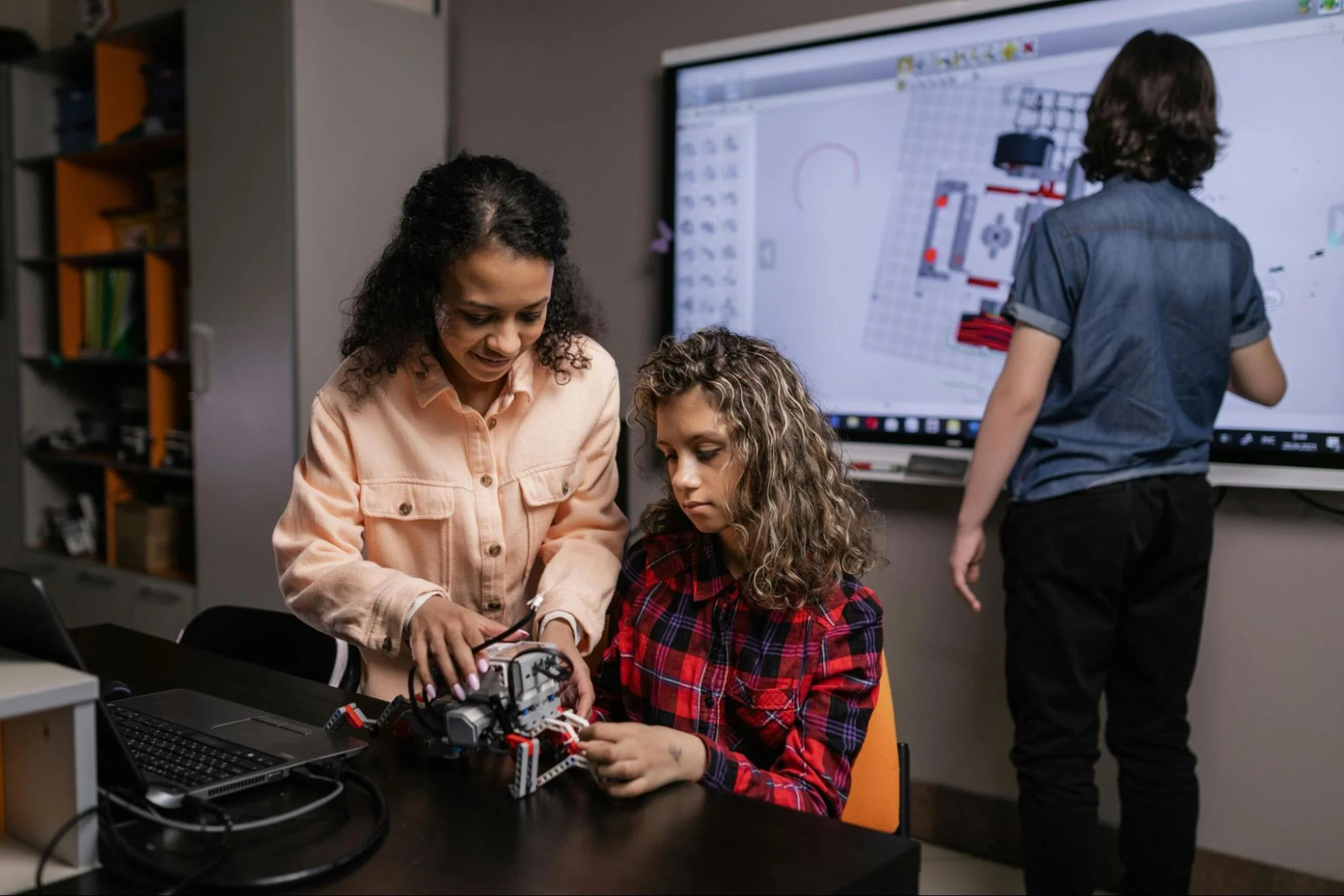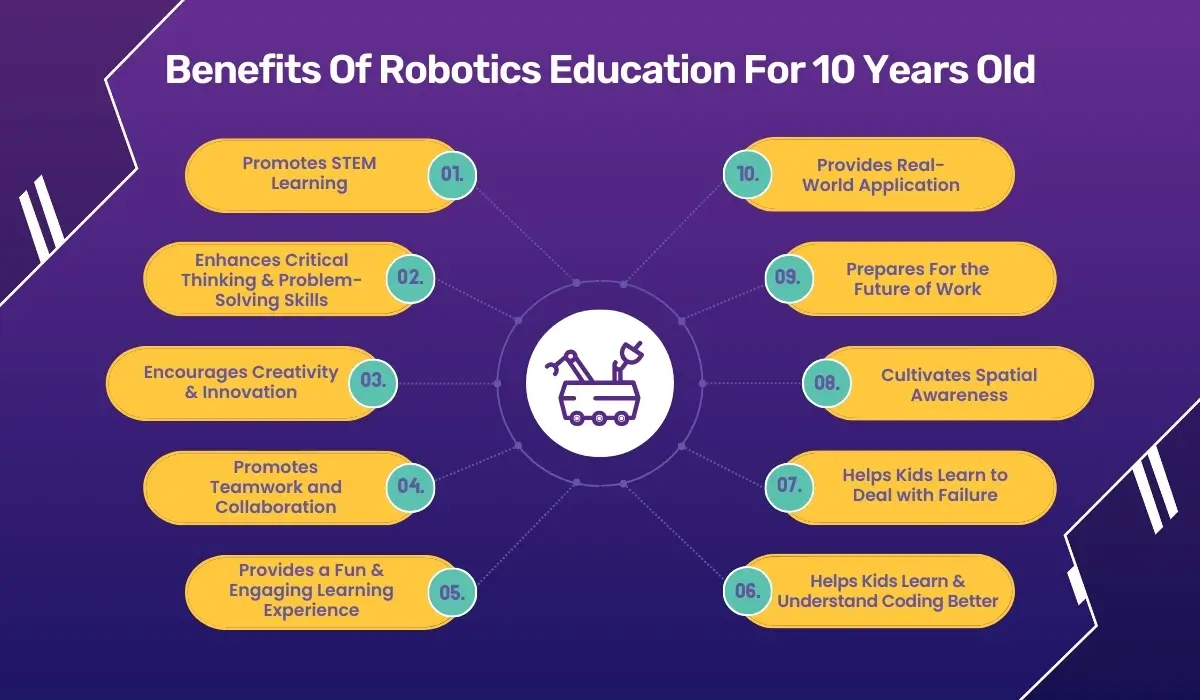
Update: This article was last updated on 6th January 2026 to reflect the accuracy and up-to-date information on the page.
Robotics education provides an engaging and dynamic learning experience that can help prepare children for the challenges of the twenty-first century by developing critical thinking, creativity, innovation, and problem-solving skills.
According to research from Tufts University’s Department of Child Development, the ideal age to realize the importance of robotics for kids is between 7 and 10. This age range is believed to be optimal for improving children’s comprehension and understanding of technology and engineering concepts, as well as promoting their interest in science and math.
You can explore this blog: How to Introduce Robotics to Kids Ages 7-8 Years: Activities, Projects & More
As more educators and parents recognize the numerous benefits of robotics for kids and young learners, its popularity has increased in the United States in recent years.
Here are 10 benefits of robotics education for 10-year-olds
1. Robotics Education Promotes STEM Learning
STEM education is critical in preparing students for future employment in industries like engineering, computer science, and medicine, making it a vital component of the American educational system. Since it gives hands-on opportunities to apply theoretical principles in real-world situations, robotics education is a great technique to encourage STEM learning for 10-year-old children.
It introduced them to basic engineering principles like mechanics, electronics, and automation, as well as programming ideas like algorithms, loops, and conditionals through designing, creating, and programming robots.
Robotics education reduces the skills gap in STEM-related areas by providing students with the knowledge and abilities they need to excel in the sector.
2. Robotics Education Enhances Critical Thinking and Problem-Solving Skills
Robotics learning for kids helps 10-year-olds’ critical thinking and problem-solving skills when they construct robots. To build a robot, they have to plan the framework, choose the parts that will make it work, program it to carry out particular duties, and debug any problems that may occur.
Students must use critical thinking skills to assess situations, weigh alternative solutions, and make sound judgments. Students who participate in robotics education acquire crucial problem-solving abilities, and they reap the benefits lifelong.
3. Robotics Education Encourages Creativity and Innovation
Robotics education for 10-year-olds encourages creativity and innovation by allowing students to use their imagination and develop problem-solving skills. This process allows them to think outside the box and develop original solutions to challenging issues.
Through hands-on learning, students can experiment with new concepts and designs, collaborate, and work towards a common objective. By fostering a collaborative and engaging learning environment, robotics education not only promotes creativity but also encourages students to develop a passion for STEM learning.
4. Robotics Education Promotes Teamwork and Collaboration
Robotics education provides 10-year-olds with an excellent opportunity to develop teamwork and collaboration skills that are essential for success in the workforce.
Through designing, constructing, and programming robots in teams, students learn to communicate clearly, listen to other’s viewpoints, and work together to achieve a common goal. These skills are valuable throughout their lives and vital for success in the workforce.
You can explore this blog: Introduction to Robotics for 12-Year-Old: A Fun and Educational Adventure
5. Robotics Education Provides a Fun and Engaging Learning Experience
Building and programming robots is an exciting activity. It keeps them engaged in the learning process. Moreover, hands-on experience is significantly more interesting for pupils than typical classroom instruction.
Students who participate in robotics education are more motivated and interested in studying, which improves academic success and performance.

6. Robotics Education Helps Kids Learn and Understand Coding Better
One of the important benefits of robotics and coding education is to learn the fundamentals of programming and its applications through robotics. They can construct real robots and learn what works and what doesn’t.
They also learn how to write exact instructions that a robot can follow. In addition, coding and programming are among the available courses that will offer many job prospects in the future.
Additionally, kids can use technology to address issue-based spaces and get an understanding of how the real world works.
7. Robotics Education Helps Kids Learn to Deal with Failure
It is difficult for anyone to accept failure or defeat, especially children. While designing and programing robots, children encounter challenges and setbacks at every level and they learn to deal with them constructively.
For instance, these setbacks offer invaluable lessons such as encouraging tenacity and resilience. They learn from their mistakes, overcome challenges, and develop a growth mindset by accepting failure as an opportunity to learn and advance.
8. Robotics Education Cultivates Spatial Awareness
It means helping kids develop an understanding of how objects relate to each other in space. When constructing and managing robotic systems, children must consider the placement of various components in connection to one another and their surroundings.
This calls for an understanding of geometric concepts such as angles, direction, and distance. For instance, they could have to determine how to drive around obstacles or how far a robot must go to get to a given location. Working with robots helps children develop their spatial awareness abilities by having them visualize and manipulate objects in space.
9. Robotics Education Prepares For the Future of Work
By engaging with robotics at a young age, children develop crucial skills such as problem-solving, critical thinking, and coding, which are highly sought after in many industries. Children who are exposed to STEM courses at an early age are likely to pursue professions in software development, robotics engineering, artificial intelligence, and other related fields.
Considering the growth of technology, there will be a greater need for qualified workers in these fields. So, exposing kids to robots early on will pay off in terms of their future job preparation.
10. Robotics Education Provides Real-World Application
By building and programming robots, kids can see firsthand how scientific principles like physics and mechanics influence the movement and behavior of their creations.
They also learn how technology, such as sensors and actuators, can be used to solve real-world problems or automate tasks. For example, robots can be programmed to navigate through obstacles like a real-life autonomous vehicle or to perform tasks like sorting objects in a warehouse, demonstrating practical applications of engineering and technology.
Children find robotics education entertaining and learn about the significance of STEM in daily life thanks to its real-world relevance.
You can explore this blog: What Is A Robot Sensor? Working & Its Applications
Final Note
In addition to the ten major benefits, robotics education provides other advantages for 10-year-olds. It enhances computer literacy as students learn to use digital tools and software programs to program and control robots.
Kids robotics programs can also promote diversity and inclusivity, as students from various backgrounds collaborate on projects.
Want to make your child future-ready with Robotics? Moonpreneur offers a tailor-made program. Reserve a spot in our free 60-minute workshop today and introduce them to the amazing world of robotics and innovations!






















Are there STEAM activities suitable for young children?
My son has tried simple STEAM activities like building towers with blocks, mixing colors to create new ones involving elements of science, engineering, and art. You should also try these with your children Alysaa